The global 5G driver amplifier market is valued at USD 347.7 million in 2025 and is set to reach USD 634.5 million by 2035, recording an absolute increase of USD 286.7 million over the forecast period. This translates into a total growth of 82.5%, with the market forecast to expand at a compound annual growth rate (CAGR) of 6.2% between 2025 and 2035. The overall market size is expected to grow by approximately 1.8X during the same period, supported by accelerating 5G network deployment, increasing demand for high-frequency communication systems, and rising requirements for enhanced signal amplification solutions across telecommunications infrastructure, mobile devices, and wireless communication applications.
The global 5G driver amplifier market represents a critical component within the telecommunications infrastructure and wireless communication industry, driven by the expanding deployment of 5G networks and the growing need for high-performance amplification solutions. These specialized amplifiers operate across millimeter-wave and sub-6GHz frequency bands, providing essential signal conditioning and power amplification for 5G base stations, terminal equipment, and various wireless communication systems. Driver amplifiers serve as intermediate stages between low-power signal sources and high-power final amplifiers, enabling optimal signal transfer and minimizing distortion in complex 5G transmission chains.
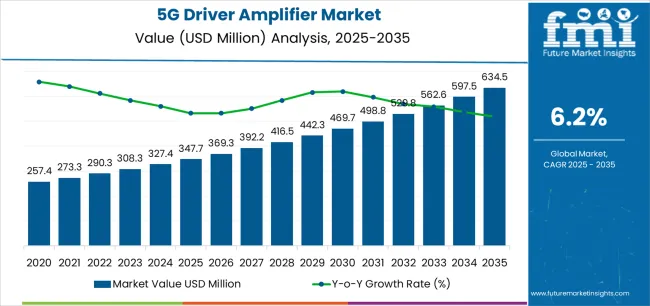
The market encompasses various semiconductor technologies including gallium arsenide (GaAs), gallium nitride (GaN), silicon germanium (SiGe), and complementary metal-oxide-semiconductor (CMOS) configurations, each offering distinct performance characteristics suited for specific 5G applications. Modern 5G driver amplifiers incorporate advanced circuit topologies, sophisticated thermal management systems, and enhanced linearity features that enable reliable operation across wide frequency ranges while maintaining power efficiency and signal integrity requirements. The integration of advanced packaging technologies, multi-stage amplification architectures, and digital predistortion capabilities has further enhanced the performance capabilities of these critical RF components.
Market dynamics are significantly influenced by the global rollout of 5G infrastructure, particularly in major telecommunications markets where network operators are investing heavily in base station deployment and capacity expansion. The telecommunications industry's emphasis on network performance, coverage optimization, and energy efficiency has created substantial demand for high-performance driver amplifier solutions across macro cells, small cells, and distributed antenna systems. Additionally, the growing adoption of 5G-enabled devices and the emergence of new applications requiring ultra-low latency and high-bandwidth connectivity has amplified the need for sophisticated amplification systems capable of supporting diverse communication scenarios.
Consumer and enterprise adoption patterns show increasing demand for 5G services across mobile broadband, enhanced mobile communications, and machine-to-machine connectivity applications. The market has witnessed significant technological advancement in semiconductor fabrication processes, circuit design methodologies, and system integration approaches, making these amplifiers more suitable for high-frequency operation, improved power efficiency, and enhanced thermal performance across demanding 5G deployment scenarios.
Between 2025 and 2030, the 5G driver amplifier market is projected to expand from USD 347.7 million to USD 442.2 million, resulting in a value increase of USD 94.5 million, which represents 33.0% of the total forecast growth for the decade. This phase of development will be shaped by accelerating 5G base station deployments, rising adoption of millimeter-wave frequency bands, and growing availability of advanced semiconductor fabrication technologies across telecommunications infrastructure and wireless communication applications.
Between 2030 and 2035, the market is forecast to grow from USD 442.2 million to USD 634.5 million, adding another USD 192.2 million, which constitutes 67.0% of the overall ten-year expansion. This period is expected to be characterized by the advancement of 6G technology development, the integration of artificial intelligence in RF system optimization, and the expansion of massive MIMO antenna systems across diverse telecommunications and wireless connectivity applications. The growing emphasis on network densification and coverage enhancement will drive demand for advanced driver amplifier varieties with improved efficiency characteristics, enhanced bandwidth capabilities, and superior thermal management performance profiles.
Between 2020 and 2024, the 5G driver amplifier market experienced rapid growth, driven by initial 5G network deployments and growing recognition of millimeter-wave technology's potential in high-speed wireless communications following extensive industry standardization efforts. The market developed as telecommunications operators recognized the advantages of advanced amplification technologies over conventional solutions in high-frequency applications and began seeking specialized components designed for 5G performance requirements. Technological advancement in semiconductor materials and circuit design began emphasizing the critical importance of maintaining signal integrity while enhancing power efficiency and improving operational reliability across diverse 5G communication applications.
| Metric | Value |
|---|---|
| Estimated Value in (2025E) | USD 347.7 million |
| Forecast Value in (2035F) | USD 634.5 million |
| Forecast CAGR (2025 to 2035) | 6.2% |
From 2030 to 2035, the market is forecast to grow from USD 442.2 million to USD 634.5 million, adding another USD 192.2 million, which constitutes 67.0% of the overall ten-year expansion. This period is expected to be characterized by the advancement of next-generation wireless technologies, the integration of advanced beamforming capabilities, and the development of specialized amplifier configurations for ultra-high frequency applications. The growing emphasis on network performance optimization and coverage enhancement will drive demand for premium varieties with enhanced efficiency characteristics, improved bandwidth capabilities, and superior integration features.
Between 2020 and 2024, the 5G driver amplifier market experienced substantial growth, driven by increasing deployment of 5G infrastructure and growing recognition of advanced amplification technologies' effectiveness in supporting reliable high-frequency communications across telecommunications networks and wireless systems. The market developed as users recognized the potential for specialized driver amplifiers to deliver performance advantages while meeting modern requirements for signal integrity and operational efficiency. Technological advancement in semiconductor fabrication and circuit optimization began emphasizing the critical importance of maintaining power efficiency while extending operational bandwidth and improving user experience across diverse 5G amplification applications.
Market expansion is being supported by the increasing global deployment of 5G telecommunications infrastructure and the corresponding shift toward high-performance RF amplification systems that can provide superior frequency response characteristics while meeting user requirements for enhanced signal quality and cost-effective network deployment solutions. Modern telecommunications operators are increasingly focused on incorporating amplifier systems that can enhance network performance while satisfying demands for consistent, precisely controlled signal amplification and optimized power consumption practices. 5G driver amplifiers' proven ability to deliver RF amplification excellence, frequency response benefits, and diverse application possibilities makes them essential components for infrastructure-focused operators and performance-oriented telecommunications professionals.
The growing emphasis on network capacity optimization and telecommunications equipment reliability is driving demand for high-performance driver amplifier systems that can support distinctive operational outcomes and comprehensive signal management across base station deployments, antenna systems, and premium telecommunications installations. User preference for amplification solutions that combine functional excellence with power efficiency is creating opportunities for innovative implementations in both traditional and emerging 5G infrastructure applications. The rising influence of Internet of Things technologies and advanced connectivity systems is also contributing to increased adoption of intelligent amplifier solutions that can provide authentic performance benefits and reliable signal processing characteristics.
The market is segmented by type, application, frequency band, power output, and region. By type, the market is divided into GaAs driver amplifier, GaN driver amplifier, SiGe driver amplifier, CMOS driver amplifier, and others. Based on application, the market is categorized into 5G base station, terminal equipment, test equipment, automotive communications, and others. By frequency band, the market includes sub-6GHz and millimeter wave categories. By power output, the market encompasses low power, medium power, and high power configurations. Regionally, the market is divided into North America, Europe, Asia Pacific, Latin America, Middle East & Africa, and other regions.
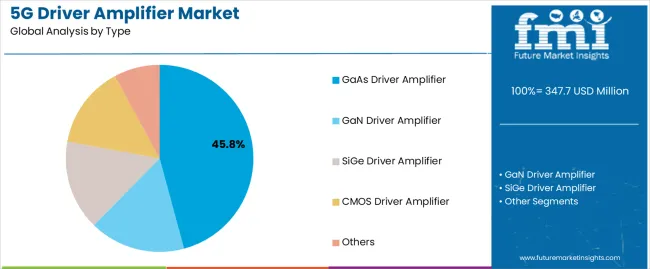
The GaAs driver amplifier segment is projected to account for 45.8% of the 5G driver amplifier market in 2025, reaffirming its position as the leading type category. Telecommunications operators and RF engineers increasingly utilize GaAs systems for their superior high-frequency performance characteristics, established reliability standards, and essential functionality in diverse millimeter-wave amplification applications across multiple telecommunications sectors. GaAs amplifiers' proven performance characteristics and established cost-effectiveness directly address user requirements for reliable signal amplification and optimal operational precision in 5G infrastructure and terminal equipment applications.
This type segment forms the foundation of modern RF amplification performance patterns, as it represents the semiconductor technology with the greatest frequency response capabilities and established compatibility across multiple 5G communication systems. Telecommunications investments in advanced fabrication technology and performance optimization continue to strengthen adoption among infrastructure-focused users. With operators prioritizing signal quality and amplification reliability, GaAs systems align with both performance objectives and efficiency requirements, making them the central component of comprehensive 5G deployment strategies.
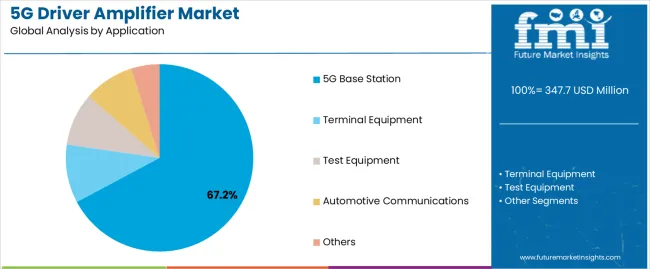
5G base station is projected to represent 67.2% of the 5G driver amplifier market in 2025, underscoring its critical role as the primary application for infrastructure-focused users seeking superior amplification benefits and enhanced telecommunications network performance credentials. Telecommunications operators and network engineers prefer base station applications for their established operational requirements, proven performance demand, and ability to maintain exceptional signal quality while supporting versatile coverage scenarios during diverse network deployment activities. Positioned as essential applications for coverage-focused operators, base station offerings provide both operational excellence and network optimization advantages.
The segment is supported by continuous improvement in 5G infrastructure technology and the widespread availability of established telecommunications standards that enable performance assurance and premium positioning at the network level. Additionally, operators are optimizing amplifier selections to support frequency-specific applications and comprehensive network deployment strategies. As 5G technology continues to advance and operators seek efficient coverage methods, base station applications will continue to drive market growth while supporting network performance and coverage optimization strategies.
The 5G driver amplifier market is advancing rapidly due to increasing 5G network deployment adoption and growing need for high-frequency amplification solutions that emphasize superior RF performance across telecommunications segments and wireless communication applications. However, the market faces challenges, including competition from integrated RF solutions, thermal management complexity considerations, and initial development cost factors affecting adoption rates. Innovation in semiconductor efficiency enhancement and advanced packaging technologies continues to influence market development and expansion patterns.
The growing adoption of 5G driver amplifiers with millimeter-wave frequency support and massive MIMO system integration is enabling users to develop network strategies that provide distinctive coverage benefits while commanding enhanced signal processing and improved capacity performance analysis characteristics. Massive MIMO applications provide superior network efficiency while allowing more sophisticated beamforming optimization features across various telecommunications categories. Users are increasingly recognizing the operational advantages of advanced amplification positioning for comprehensive network performance outcomes and technology-integrated infrastructure management.
Modern 5G driver amplifier manufacturers are incorporating advanced thermal dissipation technologies, real-time efficiency monitoring capabilities, and power optimization systems to enhance operational precision, improve equipment reliability effectiveness, and meet telecommunications demands for efficient RF amplification solutions. These systems improve operational effectiveness while enabling new applications, including continuous performance monitoring programs and automated power management protocols. Advanced thermal integration also allows users to support proactive maintenance positioning and performance assurance beyond traditional amplification operation requirements.
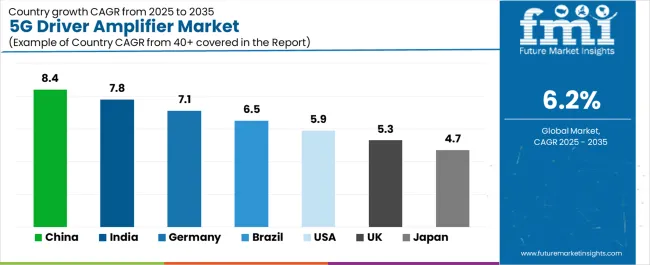
| Country | CAGR (2025-2035) |
|---|---|
| China | 8.4% |
| India | 7.8% |
| Germany | 7.1% |
| Brazil | 6.5% |
| USA | 5.9% |
| UK | 5.3% |
| Japan | 4.7% |
The 5G driver amplifier market is experiencing robust growth globally, with China leading at an 8.4% CAGR through 2035, driven by the expanding telecommunications infrastructure, massive 5G network deployments, and increasing adoption of millimeter-wave communication systems. India follows at 7.8%, supported by rising telecommunications investment, expanding mobile subscriber base, and growing acceptance of advanced wireless technologies. Germany shows growth at 7.1%, emphasizing established engineering standards and comprehensive telecommunications development. Brazil records 6.5%, focusing on telecommunications modernization and network expansion growth. The USA demonstrates 5.9% growth, prioritizing advanced 5G technologies and infrastructure optimization.
The report covers an in-depth analysis of 40+ countries, top-performing countries are highlighted below.
How Is China Driving Growth in the 5G Driver Amplifier Market?
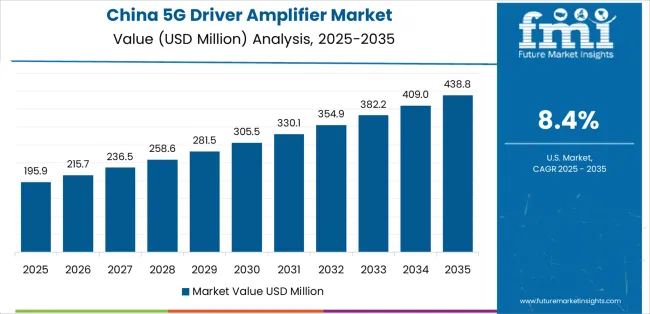
Revenue from 5G driver amplifier consumption and sales in China is projected to exhibit exceptional growth with a CAGR of 8.4% through 2035, driven by the country's rapidly expanding 5G network infrastructure, favorable government policies toward telecommunications modernization, and initiatives promoting advanced wireless technologies across major metropolitan regions. China's position as a global telecommunications leader and increasing focus on millimeter-wave deployment systems are creating substantial demand for high-quality driver amplifiers in both domestic and international markets. Major telecommunications equipment companies and RF component distributors are establishing comprehensive amplifier capabilities to serve growing demand and emerging 5G opportunities.
Revenue from 5G driver amplifier products in India is expanding at a CAGR of 7.8%, supported by rising telecommunications infrastructure investment, growing 5G deployment consciousness, and expanding equipment distributor capabilities. The country's developing wireless infrastructure and increasing investment in advanced communication technologies are driving demand for driver amplifiers across both traditional and modern telecommunications applications. International RF companies and domestic distributors are establishing comprehensive operational networks to address growing market demand for amplification devices and efficient 5G solutions.
Revenue from 5G driver amplifier products in Germany is projected to grow at a CAGR of 7.1% through 2035, supported by the country's mature engineering standards, established telecommunications regulations, and leadership in precision RF technology. Germany's sophisticated telecommunications standards and strong support for advanced 5G systems are creating steady demand for both traditional and innovative driver amplifier varieties. Leading telecommunications manufacturers and specialty distributors are establishing comprehensive operational strategies to serve both domestic markets and growing export opportunities.
Revenue from 5G driver amplifier products in Brazil is projected to grow at a CAGR of 6.5% through 2035, driven by the country's emphasis on telecommunications development, network modernization growth, and growing infrastructure distributor capabilities. Brazilian telecommunications operators and network facilities consistently seek 5G-focused equipment that enhances operational efficiency and supports modernization excellence for both traditional and modern wireless applications. The country's position as a Latin American telecommunications leader continues to drive innovation in specialized RF applications and network infrastructure standards.
Revenue from 5G driver amplifier products in the USA is projected to grow at a CAGR of 5.9% through 2035, supported by the country's emphasis on telecommunications technology advancement, 5G infrastructure optimization, and advanced network system integration requiring efficient amplification solutions. American telecommunications operators and infrastructure-focused facilities prioritize performance reliability and operational precision, making specialized driver amplifiers essential components for both traditional and modern 5G network applications. The country's comprehensive telecommunications technology leadership and advancing infrastructure patterns support continued market expansion.
Revenue from 5G driver amplifier products in the UK is projected to grow at a CAGR of 5.3% through 2035, supported by established telecommunications standards, mature 5G markets, and emphasis on operational reliability across network and infrastructure sectors. British telecommunications operators and network professionals prioritize quality performance and operational consistency, creating steady demand for premium amplifier solutions. The country's comprehensive market maturity and established telecommunications practices support continued development in specialized applications.
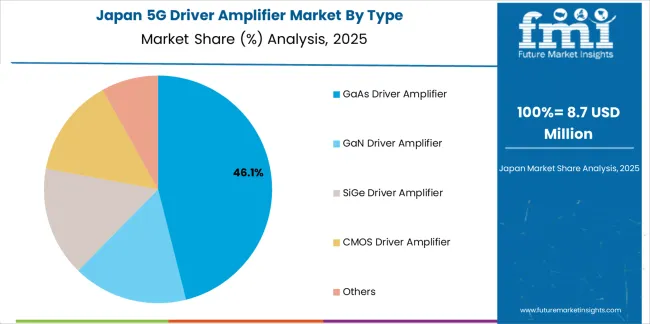
Revenue from 5G driver amplifier products in Japan is projected to grow at a CAGR of 4.7% through 2035, supported by the country's emphasis on precision telecommunications, operational excellence, and advanced technology integration requiring efficient amplification solutions. Japanese telecommunications operators and infrastructure-focused facilities prioritize technical performance and network precision, making specialized driver amplifiers essential components for both traditional and modern 5G infrastructure applications. The country's comprehensive telecommunications leadership and advancing precision patterns support continued market expansion.
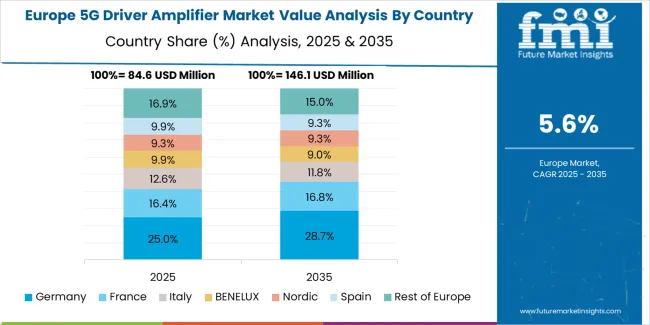
The Europe 5G driver amplifier market is projected to grow from USD 89.2 million in 2025 to USD 162.8 million by 2035, recording a CAGR of 6.2% over the forecast period. Germany leads the region with a 38.4% share in 2025, moderating slightly to 37.9% by 2035, supported by its strong engineering traditions and demand for premium, precision-manufactured amplifier solutions. The United Kingdom follows with 22.1% in 2025, easing to 21.7% by 2035, driven by a mature 5G infrastructure market and emphasis on operational reliability and quality performance. France accounts for 16.2% in 2025, rising to 16.8% by 2035, reflecting steady adoption of 5G technologies and network optimization. Italy holds 9.8% in 2025, expanding to 10.4% by 2035 as telecommunications modernization and specialty 5G applications grow. Spain contributes 6.7% in 2025, growing to 7.2% by 2035, supported by expanding telecommunications development and 5G awareness modernization. The Nordic countries rise from 4.2% in 2025 to 4.5% by 2035 on the back of strong engineering consciousness and advanced telecommunications methodologies. BENELUX remains at 2.6% share across both 2025 and 2035, reflecting mature, infrastructure-focused telecommunications markets.
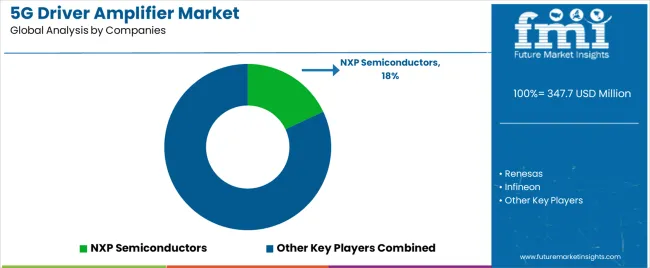
The 5G driver amplifier market is characterized by competition among established semiconductor manufacturers, specialized RF companies, and integrated telecommunications equipment providers. Companies are investing in advanced semiconductor technologies, specialized materials engineering, product innovation capabilities, and comprehensive distribution networks to deliver consistent, high-quality, and reliable driver amplifier systems. Innovation in circuit topology optimization, thermal management advancement, and 5G-focused product development is central to strengthening market position and customer satisfaction.
NXP Semiconductors leads the market with 18% share with a strong focus on RF technology innovation and comprehensive semiconductor solutions, offering telecommunications and infrastructure systems with emphasis on performance excellence and engineering heritage. Renesas provides integrated semiconductor solutions with a focus on telecommunications market applications and precision RF networks. Infineon delivers comprehensive semiconductor technology solutions with a focus on telecommunications positioning and operational efficiency. MACOM specializes in comprehensive RF systems with an emphasis on 5G applications. Analog Devices focuses on comprehensive signal processing solutions with advanced design and premium positioning capabilities.
The success of 5G driver amplifiers in meeting telecommunications infrastructure demands, network performance requirements, and operational integration will not only enhance telecommunications performance outcomes but also strengthen global RF technology manufacturing capabilities. It will consolidate emerging regions' positions as hubs for efficient semiconductor production and align advanced economies with comprehensive 5G systems. This calls for a concerted effort by all stakeholders -- governments, industry bodies, manufacturers, distributors, and investors. Each can be a crucial enabler in preparing the market for its next phase of growth.
How Governments Could Spur Local Production and Adoption?
How Industry Bodies Could Support Market Development?
How Distributors and Telecommunications Players Could Strengthen the Ecosystem?
How Manufacturers Could Navigate the Shift?
| Items | Values |
|---|---|
| Quantitative Units (2025) | USD 347.7 million |
| Type | GaAs Driver Amplifier, GaN Driver Amplifier, SiGe Driver Amplifier, CMOS Driver Amplifier, Others |
| Application | 5G Base Station, Terminal Equipment, Test Equipment, Automotive Communications, Others |
| Frequency Band | Sub-6GHz, Millimeter Wave |
| Power Output | Low Power, Medium Power, High Power |
| Regions Covered | North America, Europe, Asia Pacific, Latin America, Middle East & Africa, Other Regions |
| Countries Covered | China, India, Germany, Brazil, United States, United Kingdom, Japan, and 40+ countries |
| Key Companies Profiled | NXP Semiconductors, Renesas, Infineon, MACOM, Analog Devices, and other leading 5G driver amplifier companies |
| Additional Attributes | Dollar sales by type, application, frequency band, power output, and region; regional demand trends, competitive landscape, technological advancements in RF engineering, semiconductor optimization initiatives, 5G enhancement programs, and premium product development strategies |
The global 5g driver amplifier market is estimated to be valued at USD 347.7 million in 2025.
The market size for the 5g driver amplifier market is projected to reach USD 634.5 million by 2035.
The 5g driver amplifier market is expected to grow at a 6.2% CAGR between 2025 and 2035.
The key product types in 5g driver amplifier market are gaas driver amplifier, gan driver amplifier, sige driver amplifier, cmos driver amplifier and others.
In terms of application, 5g base station segment to command 67.2% share in the 5g driver amplifier market in 2025.






Full Research Suite comprises of:
Market outlook & trends analysis
Interviews & case studies
Strategic recommendations
Vendor profiles & capabilities analysis
5-year forecasts
8 regions and 60+ country-level data splits
Market segment data splits
12 months of continuous data updates
DELIVERED AS:
PDF EXCEL ONLINE
5G Solid State Switches Market Size and Share Forecast Outlook 2025 to 2035
5G Millimeter Wave RF Transceiver Market Size and Share Forecast Outlook 2025 to 2035
5G Testing Market Size and Share Forecast Outlook 2025 to 2035
5G in Healthcare Market Analysis Size and Share Forecast Outlook 2025 to 2035
5G Temperature-Compensated Crystal Oscillator (TCXO) Market Size and Share Forecast Outlook 2025 to 2035
5G Remote Surgery System Market Analysis - Size, Share, and Forecast Outlook 2025 to 2035
5G Telemedicine Platform Market Size and Share Forecast Outlook 2025 to 2035
5G Industrial IOT Market Size and Share Forecast Outlook 2025 to 2035
5G IoT Market Size and Share Forecast Outlook 2025 to 2035
5G in Defense Market Size and Share Forecast Outlook 2025 to 2035
5G Enterprise Private Network Market Size and Share Forecast Outlook 2025 to 2035
5G Edge Cloud Network and Services Market Size and Share Forecast Outlook 2025 to 2035
5G Automotive Grade Product Market Size and Share Forecast Outlook 2025 to 2035
5G Enterprise Market Size and Share Forecast Outlook 2025 to 2035
5G Infrastructure Market Size and Share Forecast Outlook 2025 to 2035
5G RAN Market Size and Share Forecast Outlook 2025 to 2035
5G Security Market Size and Share Forecast Outlook 2025 to 2035
5G Testing Equipment Market Analysis - Size, Growth, and Forecast 2025 to 2035
5G technology market Analysis by Technology Type, Application, Vertical, and Region – Growth, trends and forecast from 2025 to 2035
5G in Automotive and Smart Transportation Market by Solution ,Application,Industry , Warehousing & Logistics, Warehousing & Logistics, Public Safety and Others & Region Forecast till 2025 to 2035

Thank you!
You will receive an email from our Business Development Manager. Please be sure to check your SPAM/JUNK folder too.
Chat With
MaRIA